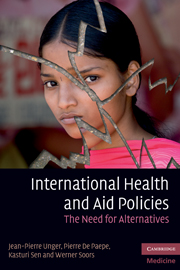Book contents
- Frontmatter
- Contents
- Preface
- Biographies
- Notices
- Acknowledgements
- List of abbreviations
- Reviews
- Introduction: Overview and purpose
- Section 1 Paradigms of international policies
- Section 2 The failure of the aid paradigm: poor disease control in developing countries
- Section 3 Impact of international health policies on access to health in middle-income countries: some experiences from Latin America
- Section 4 Determinants and implications of new liberal health policies: the case of India, China and Lebanon
- Section 5 Principles for alternative, publicly oriented health care policies, planning, management and delivery
- Section 6 A public health, strategic toolkit to implement these alternatives
- 17 Person-centred care: a key to strengthening health care and systems in low- and middle-income countries?
- 18 Improving access
- 19 Improving clinical decision making
- 20 Reorienting academic missions: how can public health departments and public health teaching in particular best support access to good quality comprehensive health care?
- Conclusions
- Glossary
- Index
- References
17 - Person-centred care: a key to strengthening health care and systems in low- and middle-income countries?
Published online by Cambridge University Press: 06 December 2010
- Frontmatter
- Contents
- Preface
- Biographies
- Notices
- Acknowledgements
- List of abbreviations
- Reviews
- Introduction: Overview and purpose
- Section 1 Paradigms of international policies
- Section 2 The failure of the aid paradigm: poor disease control in developing countries
- Section 3 Impact of international health policies on access to health in middle-income countries: some experiences from Latin America
- Section 4 Determinants and implications of new liberal health policies: the case of India, China and Lebanon
- Section 5 Principles for alternative, publicly oriented health care policies, planning, management and delivery
- Section 6 A public health, strategic toolkit to implement these alternatives
- 17 Person-centred care: a key to strengthening health care and systems in low- and middle-income countries?
- 18 Improving access
- 19 Improving clinical decision making
- 20 Reorienting academic missions: how can public health departments and public health teaching in particular best support access to good quality comprehensive health care?
- Conclusions
- Glossary
- Index
- References
Summary
Adapted from the original article ‘A plea for an initiative to strengthen family medicine in public health care services of developing countries,’ by Jean-Pierre Unger, Monique Van Dormael, Bart Criel, Jean Van der Vennet and Paul De Munck, International Journal of Health Services, 32(4), 799–815, 2002.
Introduction
Thirty years after Alma Ata, PHC activists might have strong grounds for optimism. Both evidence (Starfield et al., 2005) and policy guidance (World Health Organization, 2008) now point in the same direction. Starfield and collaborators cleared all doubts about the superior contribution of primary care to health and equity, a conclusion reconfirmed by both the Commission on Social Determinants of Health's Knowledge Network on Health Systems (Gilson et al., 2007) and the Commission's final report (Commission on Social Determinants of Health, 2008). The 2008 World Health Report promoted PHC as ‘coordinator of a comprehensive response (to people's expectations and needs) at all levels’ and some major donor agencies followed suit.
People in need of health care in LMICs might have a different perception. A slum dweller in India consulting in an urban PHC centre might find a doctor once a week, without any other drugs than those for a handful of identified TB patients. A Quechua woman anywhere between Colombia and Chile might not be able to find a doctor speaking her language. In sub-Saharan Africa any patient able to convince a health worker that their illness is other than malaria belongs to the happy few.
- Type
- Chapter
- Information
- International Health and Aid PoliciesThe Need for Alternatives, pp. 201 - 209Publisher: Cambridge University PressPrint publication year: 2010



